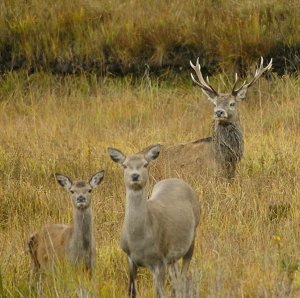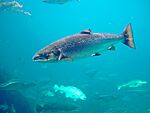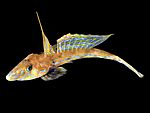Fauna of Ireland facts for kids
The fauna of Ireland includes all the amazing animal species living on the island of Ireland and in the waters around it. From tiny insects to huge whales, Ireland is home to a wide variety of creatures.
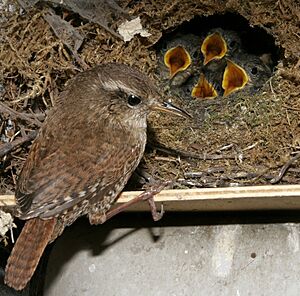
Contents
How Many Animals Live in Ireland?
Ireland has a rich animal population, both on land and in the sea. Here's a quick look at some numbers:
- There are about 290 types of sponges.
- About 302 types of jellyfish and sea anemones.
- Around 78 types of sea squirts.
- About 3 types of lampreys and 2 types of hagfish.
- Around 64 types of sharks and rays.
- About 363 types of bony fish.
- Only 4 types of amphibians.
- About 16 types of reptiles.
- Around 444 types of birds.
- About 79 types of mammals (46 on land, 33 in the sea).
- Around 192 types of starfish and sea urchins.
- About 1,774 types of crabs and lobsters.
- Around 860 types of spiders.
- About 59 types of millipedes and centipedes.
- Around 7,162 types of insects.
- About 1,088 types of snails and slugs.
- Around 321 types of segmented worms.
- About 100 types of moss animals.
- Around 111 types of parasitic worms.
Land Animals
Mammals
Ireland has only 26 types of native land mammals. This is because the island became separated from mainland Europe by rising sea levels after the last Ice Age, around 14,000 BC. This meant fewer animals could reach Ireland.
Some common mammals include the red fox, European hedgehog, stoat, otter, pygmy shrew, and badger. Other animals, like the Irish hare, red deer, and pine marten, are less common. You might see them in national parks or nature reserves.
Some animals were brought to Ireland by people and now live wild, such as the European rabbit, grey squirrel, and brown rat. Ireland is also home to ten different types of bat.
Extinct Giant Animals
During the Ice Age, many large mammals lived in Ireland. These included the woolly mammoth, wild horse, giant deer, brown bear, spotted hyena, Arctic lemming, Arctic fox, European beaver, wolf, Eurasian lynx, and reindeer. The Irish brown bear was special, with a unique genetic link to polar bears. The closest living relative to this bear is the Kodiak bear in Alaska.
Reptiles
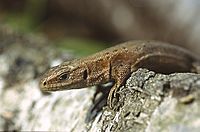
Ireland has only one native land reptile: the viviparous lizard. You can often find it in national parks, especially in the Wicklow Mountains. Slowworms are found in places like The Burren, but they are not native. They were probably brought there in the 1970s.
Five types of marine turtles are seen off Ireland's west coast. These include the leatherback, green, hawksbill, loggerhead, and Kemp's ridley. They rarely come onto land.
You might have heard stories about Saint Patrick banishing snakes from Ireland. In reality, there have never been any native snakes in Ireland. This is because Ireland lost its land bridge to Britain before snakes could travel north after the Ice Age.
Amphibians
Ireland has three types of amphibians: the common European brown frog, the smooth newt, and the natterjack toad. Some people think the frog might not be native to Ireland, suggesting it was introduced in the 1700s. The natterjack toad is very rare and only found in a few spots in County Kerry and western County Cork. These animals arrived in Ireland sometime after the ice age.
Birds
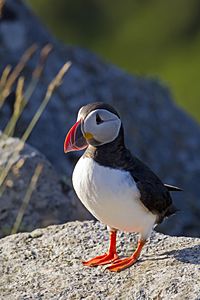
Around 400 different bird species have been seen in Ireland. Many of these are migratory birds. Some, like Arctic birds, come in winter. Others, like the swallow, fly all the way from Africa to breed in Ireland during the summer.
Ireland has fewer types of breeding birds than Britain or mainland Europe. This is because Ireland has fewer different types of habitats, like woodlands or high mountains. However, Ireland is very important for some bird species that are declining elsewhere. These include storm petrels (Ireland has the largest breeding numbers in the world), roseate tern, chough, and corncrake.
Four bird species have their own special Irish subspecies. These are the coal tit, dipper, jay, and red grouse.
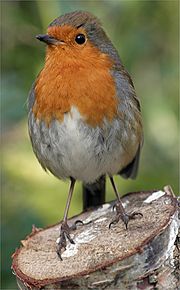
The wren, robin, blackbird, and common chaffinch are the most common birds, found in almost all parts of Ireland. Other common birds include the rook, starling, great tit, and blue tit.
Some birds, like the Kestrel, common swift, skylark, and mistle thrush, have been declining. This is due to changes in farming, such as more use of pesticides, and also due to climate change.
Ireland's coast is home to many seabird colonies, like those on the Saltee Islands and Skellig Michael.
Bird Reintroduction and Conservation
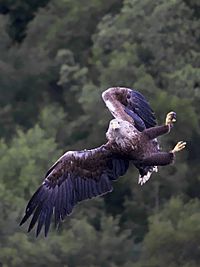
Conservation efforts are helping to bring back birds that had disappeared from Ireland.
- The golden eagle was reintroduced to Glenveagh National Park in County Donegal in 2001, after being absent for 90 years. Since then, 46 golden eagles have been released, and the first chick hatched in 2007.
- In 2006, 30 red kites from Wales were released in the Wicklow Mountains. The first red kite chick hatched in 2010.
- The white-tailed eagle returned to Ireland in 2007, with six young birds released in Killarney National Park. This was after an absence of over 200 years.
- There are also plans to bring back the common crane.
- The osprey and marsh harrier have slowly returned to Ireland on their own.
South-eastern Wexford is a very important place for birds. The North Slob is where 10,000 Greenland white-fronted geese spend the winter. This is about one-third of the world's population! In summer, Lady's Island Lake is a key breeding spot for terns, especially the roseate tern.
Three-quarters of the world's population of pale bellied brent geese spend their winter in Strangford Lough in County Down.
Fish
Ireland has 375 types of fish in its coastal waters and 40 types in its rivers and lakes. Many of these are pelagic, meaning they live in the open ocean.
The cool waters around Ireland are also home to many marine invertebrates (animals without backbones). You can see some of these in tide pools.
Twenty-four types of cetaceans (like bottlenose dolphins, orca whales, and harbour porpoises) and five types of sea turtles have been seen in Irish waters. The giant squid has also been spotted five times. The walrus is very rare but has been seen a few times around the Irish coasts.
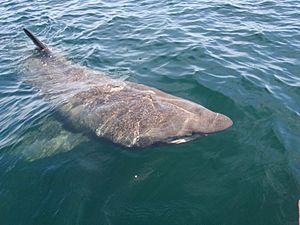
The Porcupine Abyssal Plain, a very deep part of the ocean southwest of Ireland, is home to many deep sea fish. It was first explored in the 1860s. Other interesting fish found in Irish waters include the huge basking shark, ocean sunfish, conger eel, hagfish, boarfish, large-eyed rabbitfish, lumpsucker, cuckoo wrasse, and the thresher shark.
Invertebrates
Insects and Other Arthropods

It's thought that around 11,500 types of insects live in Ireland. This includes about 1,400 types of moths, 33 types of dragonflies and damselflies, and 34 types of butterflies. Many more are still being discovered! Ireland also has 378 types of spiders.
Some special Irish invertebrates include the freshwater pearl mussel, diving bell spider, marsh fritillary butterfly, Kerry slug, and freshwater crayfish.
Extinctions
Some animals that used to live in Ireland have become extinct in recent history. These include the great auk, the Irish elk, the brown bear, Eurasian lynx, grey whale, and the wildcat. The last grey wolf in Ireland was killed in 1786.
As mentioned, many bird of prey species, like the golden eagle, white-tailed eagle, and red kite, have been successfully brought back to national parks after being absent for many years.
Zoology Museums
If you want to learn more about Ireland's animals, you can visit these museums:
- The Natural History Museum Dublin, which opened in 1856.
- The Ulster Museum in Belfast, which opened in 1929.
- Trinity College Dublin also has a Zoological museum that is open during the summer.
Animal Research in Ireland
Ireland's location on the edge of the continental shelf makes it a great place to study marine life. There are two main research stations:
- Queen’s Marine Laboratory on Strangford Lough.
- The Ryan Marine Science Institute in Galway.
Since 2000, scientists in Ireland have been working on a program called "Ag-Biota." This program studies how modern farming affects the variety of life (biodiversity).
The National Biodiversity Data Centre in Waterford also continuously monitors and researches Ireland's biodiversity.
History of Animal Studies
One of the earliest descriptions of Ireland's animals was written by Gerald of Wales in 1180. Later, in 1652, Gerard Boate published his "Natural History of Ireland."
A very important study was the Clare Island Survey (1909–1911), organized by Robert Lloyd Praeger. This was the first detailed biological survey of its kind in the world and became a model for future studies everywhere.


